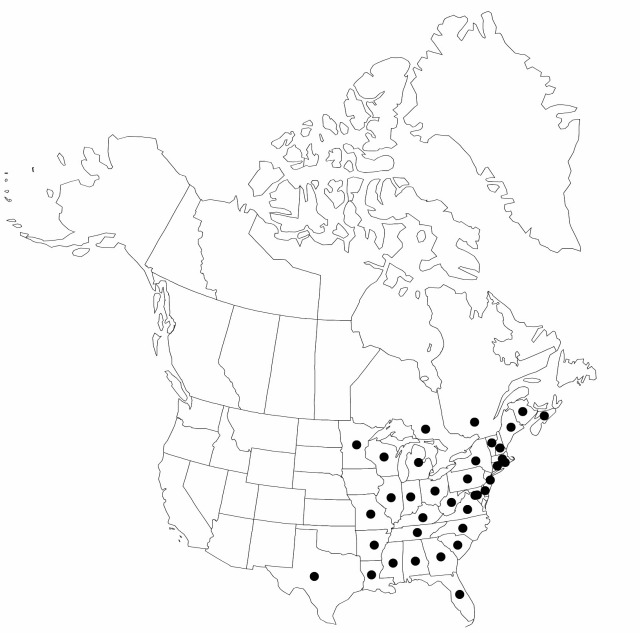Difference between revisions of "Carex bromoides"
Sp. Pl. 4(1): 258. 1805.
FNA>Volume Importer |
imported>Volume Importer |
||
| Line 6: | Line 6: | ||
|place=4(1): 258. 1805 | |place=4(1): 258. 1805 | ||
|year=1805 | |year=1805 | ||
| + | }} | ||
| + | |special_status={{Treatment/ID/Special_status | ||
| + | |code=F | ||
| + | |label=Illustrated | ||
}} | }} | ||
|basionyms= | |basionyms= | ||
| Line 19: | Line 23: | ||
-->{{Treatment/Body | -->{{Treatment/Body | ||
| − | |distribution= | + | |distribution=N.B.;N.S.;Ont.;Que.;Ala.;Ark.;Conn.;D.C.;Del.;Fla.;Ga.;Ill.;Ind.;Ky.;La.;Maine;Mass.;Md.;Mich.;Minn.;Miss.;Mo.;N.C.;N.H.;N.J.;N.Y.;Ohio;Pa.;R.I.;S.C.;Tenn.;Tex.;Va.;Vt.;W.Va.;Wis.;Mexico. |
|discussion=<p>Subspecies 2 (2 in the flora).</p> | |discussion=<p>Subspecies 2 (2 in the flora).</p> | ||
|tables= | |tables= | ||
| Line 52: | Line 56: | ||
|basionyms= | |basionyms= | ||
|family=Cyperaceae | |family=Cyperaceae | ||
| − | |distribution= | + | |distribution=N.B.;N.S.;Ont.;Que.;Ala.;Ark.;Conn.;D.C.;Del.;Fla.;Ga.;Ill.;Ind.;Ky.;La.;Maine;Mass.;Md.;Mich.;Minn.;Miss.;Mo.;N.C.;N.H.;N.J.;N.Y.;Ohio;Pa.;R.I.;S.C.;Tenn.;Tex.;Va.;Vt.;W.Va.;Wis.;Mexico. |
|reference=naczi1990a | |reference=naczi1990a | ||
|publication title=Sp. Pl. | |publication title=Sp. Pl. | ||
|publication year=1805 | |publication year=1805 | ||
| − | |special status= | + | |special status=Illustrated |
| − | |source xml=https:// | + | |source xml=https://bibilujan@bitbucket.org/aafc-mbb/fna-data-curation.git/src/bb6b7e3a7de7d3b7888a1ad48c7fd8f5c722d8d6/coarse_grained_fna_xml/V23/V23_576.xml |
|genus=Carex | |genus=Carex | ||
|section=Carex sect. Deweyanae | |section=Carex sect. Deweyanae | ||
Revision as of 21:35, 27 May 2020
Plants densely to loosely cespitose. Culms 23–88 cm × 0.5–1.6 mm, smooth. Leaves: ligules 1–3.5 mm, 1–3 times as long as wide; blades 1.1–4.4 mm wide, widest blade 1.3–4.4 mm wide. Inflorescences (12–)21–63(–71) mm; proximal internode 3.3–16(–23) mm; proximal bracts 5–24(–28) mm, awn 1.3–19 mm; spikes 3–8, usually gynecandrous, sometimes also pistillate, staminate or with pistillate and staminate flowers scattered throughout; proximal spikes with 0–2 staminate and 9–19 pistillate flowers, 10–17(–20) × 1.8–5 mm; terminal spikes usually with 0–3 staminate and 8–18 pistillate flowers, 9–20(–25) × 1.5–5 mm. Pistillate scales with pale to red-brown margins, 2.8–4.1 × 1.1–1.6 mm, apex acuminate or with awn to 0.6 mm. Staminate scales with pale to red-brown margins, 2.8–3.9 × 1.4–1.6 mm, apex acute to acuminate. Anthers 1.7–2.9 mm. Perigynia erect, green to pale brown, (3–)4–8-veined abaxially, prominently to weakly 3–6-veined adaxially, narrowly lanceolate, (3.3–)4.1–6.7 × 0.8–1.3 mm, (3.5–)4–6.1(–6.6) times as long as wide, apex abruptly contracted or gradually tapering; beak 1.2–2.2(–2.8) mm, 0.28–0.51 times as long as perigynia, margins serrulate, apex entire or bidentulate, teeth to 0.2 mm, 0–0.05 times as long as perigynia. Stigmas 2–3.4 mm. Achenes 1.7–2.2 × 0.7–1.1 mm, 1.9–2.9 times as long as wide.
Distribution

N.B., N.S., Ont., Que., Ala., Ark., Conn., D.C., Del., Fla., Ga., Ill., Ind., Ky., La., Maine, Mass., Md., Mich., Minn., Miss., Mo., N.C., N.H., N.J., N.Y., Ohio, Pa., R.I., S.C., Tenn., Tex., Va., Vt., W.Va., Wis., Mexico.
Discussion
Subspecies 2 (2 in the flora).
Selected References
Key
| 1 | Culms 0.5–1(–1.1) mm wide; widest leaf blades 1.3–2.9(–3.1) mm wide; perigynium beak 0.3–0.42 times as long as perigynium. | Carex bromoides subsp. bromoides |
| 1 | Culms 1–1.6 mm wide; widest leaf blades 2.8–4.4 mm wide; perigynium beak 0.36–0.48 times as long as perigynium. | Carex bromoides subsp. montana |